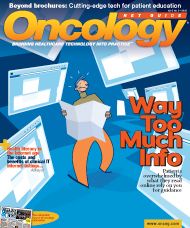Publication
Article
ONCNG Oncology
The Costs and Benefits of Health IT in Cancer Care
Despite the enormous potential of electronic health records (EHRs) and other health IT applications, very few providers have adopted them.
Because the delivery of oncology care involves many high-cost assets and ever-narrowing margins, the judicious application of health IT solutions has the potential to transform care by reducing costs, increasing efficiency, and improving quality. However, despite the enormous potential of electronic health records (EHRs) and other health IT applications, very few providers have adopted them.
Most physician offices already use information technology (billing and scheduling programs, etc) to manage the business side of practice, so many of them already have the hardware necessary to operate a full-featured EHR. However, implementing a comprehensive clinical system is a major challenge. It involves more than just making an often substantial financial commitment; it also requires a commitment to major organizational changes in nearly every aspect of practice. To realize the full benefits of an EHR, physicians must devote considerable time to personalizing the system, to training office staff, and to adapting their work processes to incorporate the new technology into the daily workflow.
Choosing the product that best suits their practice’s unique needs from among the dozens of EHR vendors is a daunting challenge for providers. With so many choices and rapidly developing technologies, many providers are concerned about buying the wrong system for their practice. Many oncologists also remain skeptical that EHRs will enable them to improve the quality of healthcare they deliver. However, EHRs have been shown to:
- Improve safety in the use of toxic chemotherapeutic agents
- Identify harmful drug interactions/allergic reactions
- Help oncologists manage complex patients with clearly accessible information flow sheets
- Identify patients who are eligible for clinical research protocols
Allow timely communication of progress to other specialists involved in multimodality care EHRs also enable oncology providers to run their practices more effi ciently by eliminating the use of medical transcription and the need to physically pull medical charts. EHRs reduce practice variation by promoting adherence to formularies and internal limited protocols and allow physicians to defi ne protocol-driven care for use by extenders. However, potential EHR users must keep in mind that not every practice will realize all of these benefi ts. For example, eliminating chart pulls reduces costs but only for larger offices. Because the staff at smaller offices often perform multiple functions, these practices are less able to reduce staff to cut costs.
How much will it cost?
Estimating the total cost of implementing EHR systems in offi cebased oncology practices is complicated by the sheer number and variety of systems available. Implementing an EHR involves not only direct costs (for hardware, software, licensing fees, installation, and training), but also indirect costs (eg, practitioners’ reduced productivity during the early stages of adoption). Total cost for an offi ce-based EHR can be as much as $45,000 per physician. Estimates of annual costs for operating and maintaining the system (including software licensing fees, technical support, and updating and replacing used equipment) range from 12%—20% of initial costs. Fortunately, the prices of health IT products appear to be falling. In particular, Internet-based applications are becoming available and may limit costs to an annual subscription fee as low as $2,000 per physician.
Several studies have shown that practice productivity can decrease by at least 10% for several months following EHR implementation. In some non-oncology studies, the average drop in revenue from that loss of productivity was about $7,500 per physician. These issues are discussed in great detail in a recently released Congressional Budget Office report on the costs and benefi ts of health IT. The report reinforces the need for answers to some of the core questions raised in my last column: How will we demonstrate value to our patients and even payers? How good is the cancer care we are providing? How do we compare to providers elsewhere? What are the tools we will use to engage our patients? Adopting clinical IT systems will enable us to collect critical information as a byproduct of workfl ow, answer these questions, and improve the health outcomes that are the ultimate measure of performance.
Jivesh Sharma, MD, is CEO of Texas Cancer Associates, a midsize oncology practice based in Dallas/Fort Worth, TX. He is also CEO of HealthIT, an Internet services company that supports the patient/ provider network with technology solutions, and founder of NextGen Oncology, which works to provide next-generation solutions for the diagnosis, management, and treatment of cancer. E-mail Dr. Sharma at JSharma@MyCancerCenter.com.
